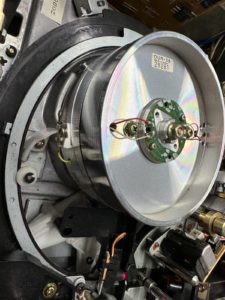Recently, we digitized ¾-inch Sony U-matic cartridges that had sat in storage for about four decades — with no considerations for humidity, heat, or other factors that could cause signal loss.
That project was largely successful, but it highlights the importance of proper video cassette storage. While we have developed proprietary techniques to obtain the best possible signal quality, digitization is limited by the quality of the analog media. When U-matic tapes lose visual or audio information, that information may be gone forever.
With that in mind, let’s discuss why digitization is crucial — and how storage conditions can impact the quality of an analog video archive.
1. Over time, U-matic tape binders break down.
¾-inch tapes aren’t especially complex. They contain a binder, an adhesive with polyurethane that holds oxide atoms to the tape.
The oxide atoms represent the video and audio signal. The binder also contains lubricants that allow the tape to pass smoothly over the heads that read the video/audio information.
Eventually, the binder undergoes a chemical change that results in the urethane rising to the top of the surface of the tape. This is called sticky-shed syndrome, for reasons that are obvious if you’ve ever dealt with an older tape:
- The tape sticks to the reels of the deck, often creating an unpleasant sound.
- Playing the tape will leave visible material on the heads of the tape deck.
- During playback, the video may distort and the audio may fall out of alignment.
- As degradation progresses, large portions of video/audio may become totally unreadable.
This issue can be partially reversed by “baking” the tapes — storing the tapes for a short period of time in a high-temperature environment with controlled humidity. This doesn’t mean that U-matic tapes can be treated in an oven. “Baking” is a technical process, and the quality of the “bake” will directly affect the health of the tape.
After baking, a U-matic tape will continue breaking down. It’s important to digitize tapes with sticky-shed syndrome as soon as possible — and to get the highest quality transfer possible, since the tape may be unusable in the future.
Related: A Brief History of Broadcast Video Formats
2. Excessive humidity can contribute to sticky-shed syndrome
Since hydrolysis occurs due to water absorption, it’s important to store U-matic tapes (and other analog and digital video cassettes) in a cool, dry space.
Unfortunately, proper storage does not completely prevent tape degradation. Ambient air has a certain amount of humidity, and U-matic binders will eventually absorb some water; hydrolysis is effectively unavoidable, even under precise storage conditions.
With appropriate storage, a U-matic tape can retain its signal quality for 20 years. The tape is still readable after this point, but some amount of signal degradation will occur.
In addition to binder deterioration, other issues can cause tape degradation:
- If tapes were in regular use, the control track playback and tracking can suffer due to mechanical wear.
- Tension control issues can cause slippage, which can cinch the tape during playback.
- Layers of tape can stick together. This is called blocking, and may occur due to high heat.
U-matic ¾-inch tapes should be inspected and treated prior to digitization. Playing a degraded tape can cause irreversible physical damage.
Related: Why Pay for Sony U-Matic Conversion?
3. U-matic tape decks also degrade over time.
Sony no longer produces U-matic tape decks, and like all mechanical devices, video playback equipment becomes less reliable over time. Even if your organization has a library of U-matic decks, you’ll need to inspect your equipment thoroughly before attempting digitization on your own — head clogs and other issues can damage the source media.
At Datarecovery.com, we’ve developed specialized processes for U-matic digitization. Each tape is thoroughly inspected, cleaned, and coated with lubricant prior to playback. When necessary, we can treat tapes with sticky-shed syndrome in controlled environments, using non-destructive techniques to preserve signal quality.
Related: Sony U-matic: Analog to Digital Conversion for Video Professionals
Work with a leader in Sony U-matic digitization.
If you have a large library of U-matic tapes, we strongly recommend digitization. Older libraries are constantly losing signal quality, and while the digitization process requires technical skill, it’s essential for long-term archiving.
Features of our U-matic digitization service include:
- Return of media in a variety of digital formats, including lossless formats.
- Custom-built media archive databases, with options for categorizing tapes based on a wide variety of parameters (date, program name, audio contents, and more).
- Flexible service options for managing costs while restoring videos within a set timeline.
- Secure tape disposal options.
- Support for all analog video formats, including Sony U-Matic, Betacam, DigiBeta, and more.
- High capacity capabilities with secure laboratories and closed networks.
If you’re ready to preserve your U-matic archives, we’re here to help. Call 1-800-237-4200 to get started or set up a case online.






